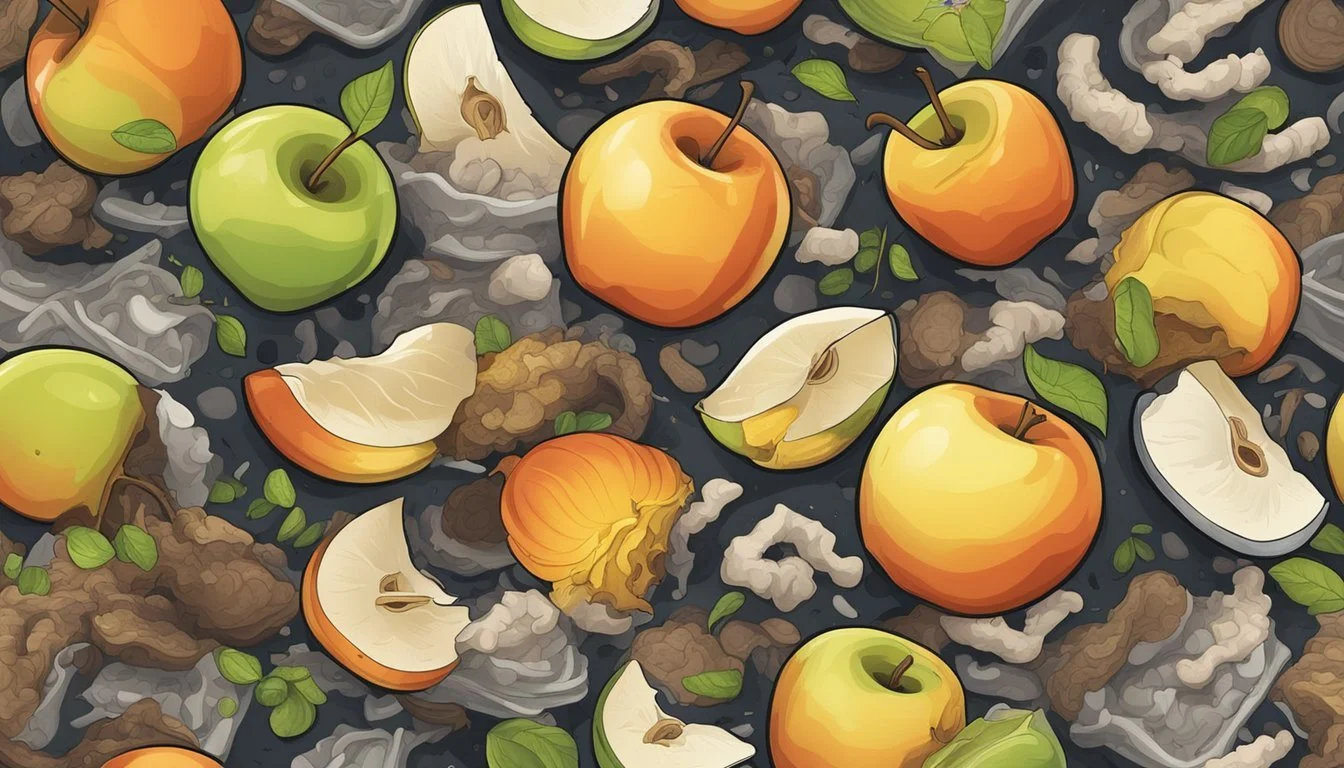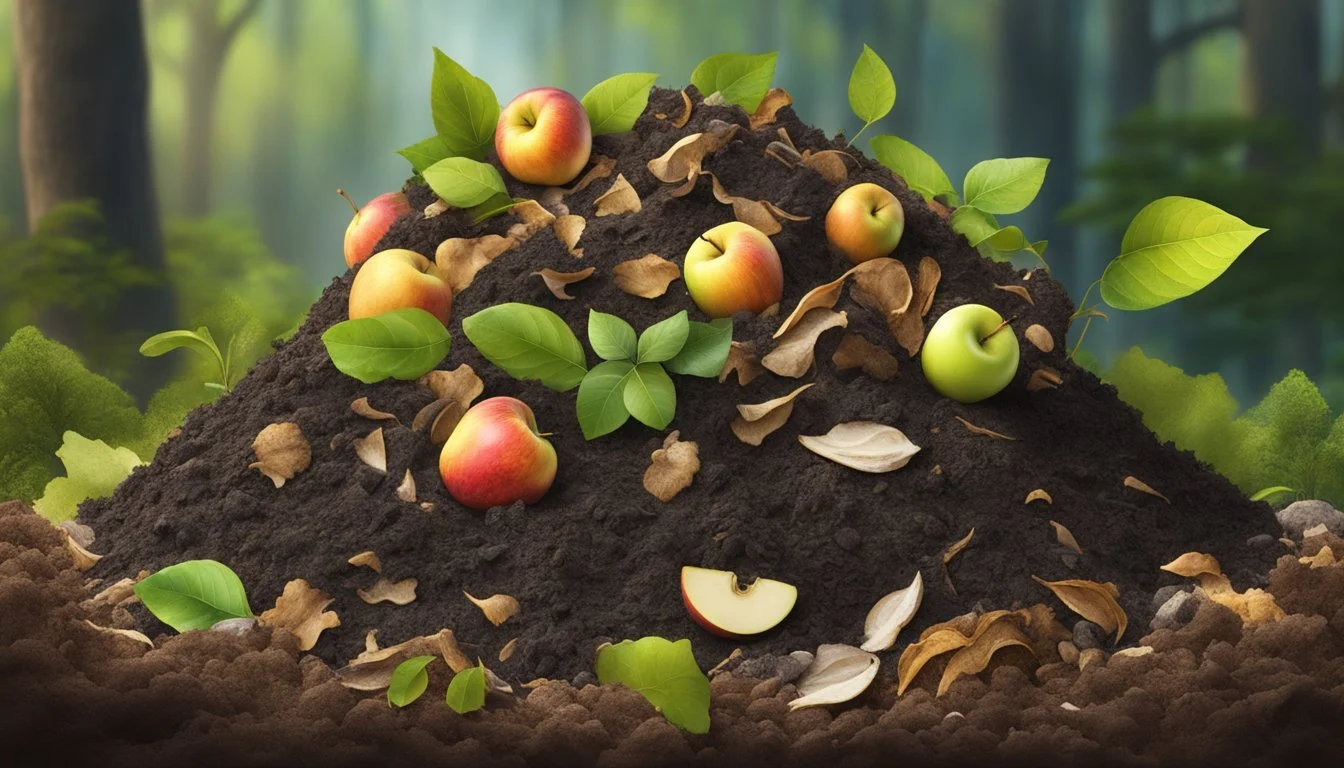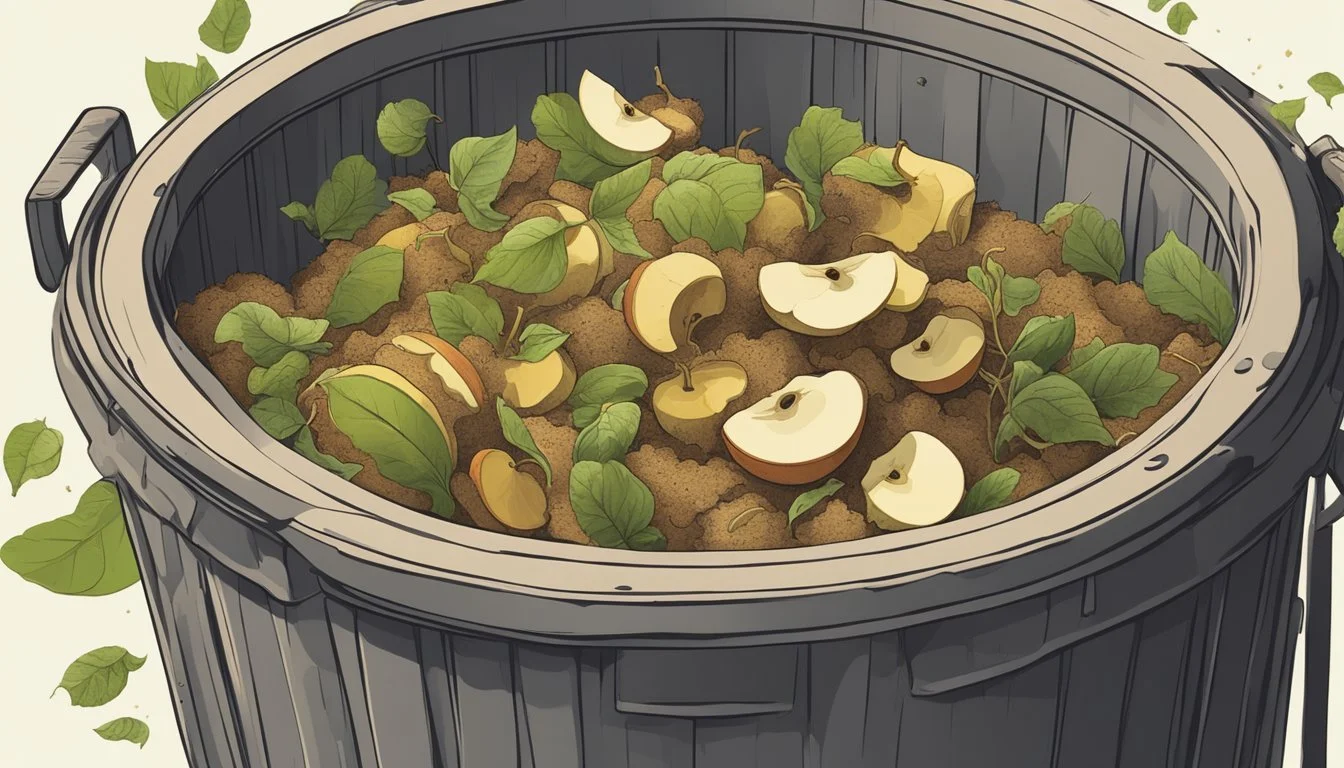Can You Compost Apple Cores?
Understanding Fruit Waste Management
Composting is a widely adopted practice for recycling kitchen waste into nutrient-rich soil. Apple cores are among the many organic materials that can be successfully composted. These cores are a natural byproduct of apple consumption and are classified as 'green material' in the composting process. Their addition to compost contributes to a balanced mix of nitrogen, which is essential for the decomposition undertaken by microorganisms in the pile or bin.
When adding apple cores to compost, it is important to maintain the right balance of 'green' and 'brown' materials—the greens being rich in nitrogen, like apple cores and vegetable scraps, and the browns providing carbon, such as dry leaves, straw or paper. This balance ensures efficient breakdown of the materials and avoids issues such as unpleasant odors or pest attraction. While apple cores decompose relatively quickly, cutting them into smaller pieces can hasten the process even further.
Attention should also be given to the quantity of apple cores being added, especially in large amounts, as the natural acidity could affect the pH balance of the compost. In such cases, amendments like white lime can be included to neutralize excess acidity, promoting a more favorable environment for composting to take place.
Basics of Composting
Understanding the fundamentals of composting empowers individuals to transform organic waste into a valuable soil amendment. This section discusses the core concepts behind composting, highlights its environmental benefits, and outlines common materials suitable for the process.
What Is Composting?
Composting is a natural process where organic matter decomposes to form a dark, rich substance called compost. This process involves microorganisms, such as bacteria and fungi, breaking down organic materials in the presence of oxygen. The result is nutrient-rich soil that enhances plant growth by improving soil structure, moisture retention, and overall health.
Benefits of Composting
Incorporating composting into waste management has several advantages:
Reduces landfill waste: Diverting organic material from landfills reduces methane emissions, a potent greenhouse gas.
Enhances soil quality: Compost adds essential nutrients to the soil, fostering better plant growth and soil structure.
Conserves resources: Using compost can diminish the need for chemical fertilizers, lowering dependence on non-renewable resources.
Common Compostable Materials
A well-balanced compost pile contains a mix of green and brown materials. Green materials are nitrogen-rich and include items such as:
Fruit and vegetable scraps (e.g., apple cores)
Grass clippings
Coffee grounds
Brown materials are carbon-rich, providing necessary energy for the composting organisms, and they include:
Dry leaves
Straw
Shredded paper
It is essential to maintain the right balance between these materials to ensure efficient decomposition and to produce high-quality compost.
Understanding the Composting Process
In the composting process, organic materials break down into a nutrient-rich soil amendment through a series of steps involving microorganisms, moisture, and the right balance of carbon and nitrogen.
Decomposition Process
Decomposition is the core of composting where organic waste is broken down by microorganisms such as bacteria and fungi. These microscopic creatures consume waste as food, transforming it into compost. The speed of decomposition is influenced by factors including temperature, moisture, and oxygen availability, with optimal conditions accelerating the process.
Carbon to Nitrogen Ratio
The balance between carbon and nitrogen is crucial for efficient composting. Materials rich in carbon are known as 'browns' and provide energy for microorganisms. Those rich in nitrogen, known as 'greens', supply protein needed for microorganism growth. An ideal carbon to nitrogen ratio (C) is about 30:1.
"Browns" (High-Carbon) "Greens" (High-Nitrogen) Dry leaves Vegetable scraps Straw Fruit waste, like apple cores Paper Coffee grounds
Microorganisms at Work
The breakdown of organic matter is driven by the work of bacteria and fungi. The variety and number of these microorganisms within a compost pile depend on temperature and moisture levels:
Bacteria are the most numerous and are divided into psychrophiles, mesophiles, and thermophiles, based on the temperatures they thrive in.
Fungi break down tough debris, often preparing the stage for bacteria to further decompose the material.
Together, these microorganisms require adequate oxygen to function, which is why aeration through turning the compost pile is recommended. Moreover, maintaining proper moisture levels is essential, as too much water can create anaerobic conditions, leading to bad odors, while too little can slow down the composting process.
Composting Apple Cores
Composting apple cores is a beneficial practice for garden health and waste reduction. The inclusion of apple cores in compost can accelerate the breakdown process and contribute to soil fertility.
Pros and Cons of Composting Apple Cores
Pros:
Nutrient-Rich Compost: Apple cores contribute to a balanced compost pile by adding nitrogen-rich material, which is essential for healthy plant growth.
Waste Reduction: By composting apple cores, one can significantly reduce household food waste and its environmental impact.
Cons:
Pests: If not managed properly, adding apple cores to compost can attract pests like rodents and insects.
Cyanide in Seeds: Apple seeds contain small amounts of cyanide; however, they would need to be present in large quantities to cause harm when composted.
How to Compost Apple Cores Effectively
Chop Them Up: Cutting apple cores into smaller pieces will expedite their decomposition.
Balance Materials:
Add brown materials, such as dry leaves or straw, to the compost along with apple cores to maintain the necessary carbon to nitrogen ratio.
This balance keeps the compost aerated and controls moisture levels.
Bury the Cores:
Dig a small trench in the compost pile and bury the apple cores. This helps to deter pests from being attracted to the compost.
Maintain Your Compost:
Turn the compost regularly to aerate it, which helps to speed up the composting process and distribute the decomposing apple cores evenly.
By following these steps, gardeners can ensure apple cores are composted effectively, supporting both environmental sustainability and garden health.
Key Components of a Healthy Compost Pile
For a compost pile to thrive, one must carefully balance its contents and maintain proper moisture and aeration. Understanding these essentials ensures the transformation of waste into a valuable soil amendment.
Balancing Compost Ingredients
A compost pile requires a balance between green and brown materials. Green materials are nitrogen-rich and include apple cores, grass clippings, and coffee grounds. They are essential for heat generation, which is key to the decomposition process. Brown materials, on the other hand, are carbon-rich and provide energy for the microorganisms at work in the compost. Examples of brown materials are leaves, straw, and wood chips. An ideal compost pile should maintain a carbon to nitrogen ratio (C) of about 30:1. Use the following as a guideline:
Green Materials (Nitrogen-Rich):
Fruit and vegetable scraps (like apple cores)
Fresh grass clippings
Coffee grounds and filters
Brown Materials (Carbon-Rich):
Dry leaves
Cardboard
Newspaper strips
Managing Moisture and Aeration
Moisture and aeration are critical for microorganisms in the compost bin to break down the materials effectively. The compost should be as moist as a wrung-out sponge. If the compost is too wet, it becomes anaerobic and creates unpleasant odors; if it's too dry, the decomposition process significantly slows down.
One can manage moisture by:
Adding dry brown materials to absorb excess water.
Watering the compost during dry periods.
Aeration can be managed by:
Regularly turning the contents of the compost bin or pile to introduce air.
Ensuring the compost bin allows for airflow, possibly through the use of a tumbler or ventilation holes.
It's crucial to mix the different materials and allow for even aeration throughout the pile to maintain a healthy decomposition process. A well-maintained compost pile will not only facilitate the breakdown of materials, including seeds and cores, but will also improve the overall soil structure as a soil amendment.
Materials to Exclude From Your Compost
Composting is an excellent way to recycle organic waste and enrich soil, but not everything belongs in the compost bin. Some items may attract pests, create odors, or even harm plants when they are eventually applied as compost. Here are specific materials to leave out.
Harmful Organic Materials
Meat and Dairy Products: They can attract pests and produce foul odors as they decompose. Bones and meat scraps are particularly problematic, as they can take a very long time to break down.
Meat (including bones)
Dairy products (such as cheese and butter)
Diseased Plants: These can spread pathogens to the compost, which might then be transferred back to your garden, potentially infecting healthy plants.
Plants with noticeable diseases or infections
Weeds: Some weeds can survive the composting process and spread through compost, leading to an unintentional spread of weeds where the compost is applied.
Weeds, especially those that are seeding or have invasive root systems
Non-Biodegradable Items
Synthetic Chemicals and Oils: Non-natural oils can contaminate compost and are not broken down by the composting process, posing a risk to soil health.
Cooking oil and grease
Oil-based salad dressings and sauces
Plastics and Metals: These materials do not decompose and can create physical hazards in the compost.
Any form of plastic packaging
Metal objects of any kind
Composting supports sustainability and improves garden health, but it's crucial to exclude certain items to maintain a safe and effective composting process.
Troubleshooting Common Composting Issues
When composting apple cores, one may occasionally encounter concerns such as unpleasant odors and persistent pests, or issues with the speed at which apple cores decompose. Understanding and mitigating these challenges are crucial to maintaining a healthy compost process.
Odors and Pests
Odors: A healthy compost pile should have a pleasant, earthy smell. If it emits a strong, foul odor, it can be a sign of anaerobic decomposition due to excess moisture or lack of aeration. To fix this:
Ensure adequate aeration by turning the compost regularly.
Balance the compost by adding more brown materials (like dry leaves or straw) to absorb excess moisture.
Pests: Fruit flies and rodents can be attracted to compost bins containing food waste like apple cores.
To deter pests, cover apple cores with a layer of soil or browns.
Use a bin with a tight-fitting lid or a layer of wire mesh to prevent access.
Slow Decomposition
Temperature: Microorganisms responsible for breaking down organic matter require an optimum temperature range to thrive. If decomposition is slow:
Locate your compost pile in a spot where it can get ample sun exposure to maintain warmth.
Mix in greens (like grass clippings) to generate natural heat during decomposition.
Balance: An appropriate balance of greens (nitrogen-rich materials) and browns (carbon-rich materials) is essential for expedient composting.
Maintain a ratio of roughly 1 part greens to 3 parts browns.
Chop apple cores into smaller pieces to increase surface area for microorganisms to work more efficiently.
By identifying and addressing these issues, one can ensure that apple cores and other compostable materials break down effectively to enrich soil health.
Enhancing Soil Fertility With Compost
Composting apple cores and other organic materials can significantly improve soil fertility and promote healthy plant growth. This sustainable practice enriches the soil with necessary nutrients, while also enhancing the soil's physical properties.
Compost as Fertilizer
Compost is a natural fertilizer that slowly releases nutrients like nitrogen, phosphorus, potassium, and calcium into the soil. These nutrients are crucial for plant growth and overall soil health. Unlike synthetic fertilizers, compost provides a balanced nutrient supply without the risk of chemical run-off.
Nutrient Content in Compost:
Nitrogen: Essential for leaf growth
Phosphorus: Important for root development
Potassium: Enhances overall plant health
Calcium: Vital for cell wall structure and growth
Improving Soil Structure
In addition to providing nutrients, compost improves soil structure, which is integral to soil health.
Increased porosity: Compost, being rich in organic materials, enhances the soil's porosity, allowing roots to expand and breathe more easily.
Enhanced water retention: Healthy soil can hold water more effectively, reducing the need for frequent watering and protecting plants during dry periods.
Disease suppression: The addition of compost can help suppress soil-borne diseases, leading to healthier plant growth.
Through regular incorporation of organic compost into the soil, one can foster a more fertile and robust garden ecosystem.
Environmental Impact and Sustainability
Composting apple cores is a simple action that significantly impacts waste reduction and promotes environmental sustainability. This section explores how composting these organic materials can mitigate landfill impacts and foster a sustainable environment.
Reducing Waste and Landfill Impact
When individuals choose to compost apple cores instead of discarding them, they effectively reduce the volume of waste conveyed to landfills. A primary environmental concern with landfills is the production of methane, a potent greenhouse gas. Organic matter, such as apple cores, undergoes anaerobic decomposition in landfills, releasing methane into the atmosphere. By composting, one interrupts this cycle, decreasing methane emissions and the overall ecological footprint.
Composting for a Sustainable Environment
Composting apple cores, along with other organic materials, transforms waste into a resource. A compost pile that integrates apple cores becomes a rich source of nutrients for garden soils, enhancing soil structure and fertility. This not only contributes to a sustainable environment by natural recycling of organic matter but also helps in maintaining a balance in the ecosystem. Composting is a practical embodiment of sustainable practices, turning everyday waste into beneficial, reusable compost.
Advanced Composting Techniques
This section explores intricacies of vermicomposting and the comparative benefits of hot versus cold composting methods to optimize apple core decomposition.
Vermicomposting
Vermicomposting involves using specific species of earthworms, typically red wigglers, to decompose organic matter. In a well-maintained worm bin, these worms will consume apple cores and turn them into worm castings—nutrient-rich compost ideal for gardening. Instead of just throwing apple cores into a pile, they are placed in a worm bin with bedding material such as shredded newspaper or cardboard for worms to thrive and facilitate faster breakdown.
Hot vs. Cold Composting
Composting can occur at varying temperatures, each affecting the speed of decomposition:
Cold Composting: This is a passive composting approach where organic matter is collected in a pile and left to decompose over time. Apple cores added to a cold compost pile will break down, but the process may take several months to a year.
Hot Composting: Also known as active composting, this method generates higher temperatures (between 135°F and 160°F), significantly accelerating decomposition. Maintaining these temperatures involves regular turning of the compost pile and careful balancing of green (nitrogen-rich) and brown (carbon-rich) materials. Apple cores in a hot compost system can decompose in as little as a couple of months.
By understanding the specific requirements of vermicomposting and the differences between hot and cold composting techniques, individuals can more effectively compost apple cores and contribute to a sustainable cycle of organic waste to soil enrichment.
Practical Tips for Home Composters
Effective composting requires attention to detail and knowledge about how to balance diverse materials. This section will provide concrete advice on selecting the appropriate bin for composting and strategies to optimize the composting process, with a particular focus on apple cores and other kitchen scraps.
Choosing the Right Compost Bin
When starting a compost heap, the choice of a compost bin is critical. Home composters should choose a bin that accommodates their space and the volume of waste they'll produce. Bins can range from enclosed plastic containers, which deter pests and maintain moisture, to open wooden frames that encourage airflow. Composting works best when the bin allows for:
Adequate airflow: Essential for aerobic decomposition
Easy access: To turn and mix the compost
Moisture retention: Dry conditions slow down the composting process
Rodent resistance: Closed bins prevent unwanted visitors
Here are some recommendations for types of compost bins that can suit different needs:
Compost Bin Type Best For Tumbler Small spaces and quick, easy turning of compost Stationary bin Larger volume composting with more kitchen and yard waste Worm bin Indoor composting or limited outdoor space
Getting the Most Out of Your Compost
For compost to break down effectively, a balance of green (kitchen scraps) and brown (yard waste) materials must be maintained. About 2-3 parts brown to 1 part green is ideal. This ratio ensures proper decomposition which should be applied when adding apple cores to the pile. Here are a few tips to optimize the composting process:
Cut or break apple cores: Smaller pieces decompose faster.
Mixing materials: Regularly turning the compost ensures even decomposition.
Balancing moisture: If the compost is too dry, consider adding water or wetter green materials. If too wet, add more brown materials.
Monitoring temperature: A healthy compost pile will generate heat as it decomposes.
One should also monitor for any signs of imbalance, such as unpleasant odors or a slow decomposition rate, and adjust the materials accordingly. By following these practices, composters can transform their kitchen scraps, including apple cores, into nutrient-rich soil, ready to enhance the next season's garden.
Composting FAQs
Can you compost apple cores?
Yes, apple cores can be composted. They are considered "green" material and decompose well in a compost heap.
What materials can be included in a compost heap?
One can compost fruit and vegetable scraps, coffee grounds, eggshells, and yard waste. However, meat, dairy, and oils should be avoided as they can attract pests and cause odor problems.
Is composting apple cores eco-friendly?
Composting apple cores, along with other organic kitchen waste, is an eco-friendly practice. It reduces landfill waste and leads to the production of nutrient-rich soil.
How long does it take for apple cores to decompose in a compost pile?
On average, apple cores take about two months to decompose in a compost pile, though this can vary based on conditions.
Are there different methods for composting apples?
Yes, apple cores can be composted through various methods such as cold composting, hot composting, and trench composting.
Can you add apple peels to vermicompost?
Apple peels can be added to vermicompost. Worms can break down the peels, contributing to the nutrient content of the compost.
What are the benefits of composting?
Composting turns kitchen scraps into valuable compost, enriches soil, helps retain moisture, and suppresses plant diseases and pests. It also lowers one's carbon footprint by reducing methane emissions from landfills.







